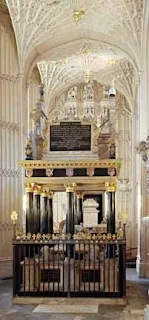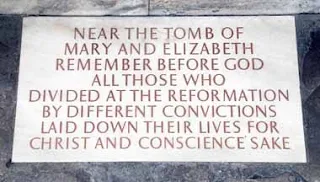Remembering Queen Elizabeth I On Her Funeral Day
Funeral of Queen Elizabeth I
Queen Elizabeth I was the daughter of King Henry VIII by Anne Boleyn and was born at Greenwich 7 September 1533 and died at Richmond 24 March 1603. She was crowned at Westminster Abbey on 15 January 1559 by Dr Oglethorpe, Bishop of Carlisle. The Archbishop of Canterbury usually performs this ceremony but the See (Bishop's Diocese) was vacant at that time and the Archbishop of York refused to take the service. The service was partly in Latin and partly in English. Queen Elizabeth was the Foundress of the present Collegiate Church in 1560 and her long reign was one of the most brilliant in English history.
Her death was an occasion of universal mourning. Thousands of people turned out to see her funeral procession to the Abbey on 28 April 1603. John Stow, who attended the funeral, wrote:
"Westminster was surcharged with multitudes of all sorts of people in their streets, houses, windows, leads and gutters, that came to see the obsequy, and when they beheld her statue lying upon the coffin, there was such a general sighing, groaning and weeping as the like hath not been seen or known in the memory of man"
She was first buried in the vault of her grandfather, King Henry VII, in the Abbey. Her successor, King James I, erected the large white marble monument to her memory in the north aisle of the Lady Chapel at a cost of £1485. This was made by sculptor Maximilian Colt and painted by Jan de Critz and her body was moved to it in 1606. Elizabeth I was the last monarch buried in the Abbey to have a monument erected above her.
The recumbent effigy resembles portraits of the Queen in old age. The crown and collar which she wears are modern replacements, as are the orb and sceptre she carries, the originals having been stolen centuries ago. The original wax effigy carried on her funeral hearse was remade in 1760 and it can be seen in the Abbey Museum. Also displayed there is the so-called "Essex Ring" that the Queen is said to have given to one of her favourites, the Earl of Essex. Her half-sister, Queen Mary Tudor, (1516-1558), daughter of Henry VIII by Catherine of Aragon, is also buried beneath this monument.
The inscriptions are in Latin and can be translated:
"Sacred to memory: Religion to its primitive purity restored, peace settled, money restored to its just value, domestic rebellion quelled, France relieved when involved with intestine divisions; the Netherlands supported; the Spanish Armada vanquished; Ireland almost lost by rebels, eased by routing the Spaniard; the revenues of both universities much enlarged by a Law of Provisions; and lastly, all England enriched Elizabeth, a most prudent governor 45 years, a victorious and triumphant Queen, most strictly religious, most happy, by a calm and resigned death at her 70th year left her mortal remains, till by Christ's Word they shall rise to immortality, to be deposited in the Church [the Abbey], by her established and lastly founded. She died the 24th of March, Anno 1602 [this is Old Style dating, now called 1603], of her reign the 45th year, of her age the 70th.
To the eternal memory of Elizabeth queen of England, France and Ireland, daughter of King Henry VIII, grand-daughter of King Henry VII, great-grand-daughter to King Edward IV. Mother of her country, a nursing-mother to religion and all liberal sciences, skilled in many languages, adorned with excellent endowments both of body and mind, and excellent for princely virtues beyond her sex. James, king of Great Britain, France and Ireland, hath devoutly and justly erected this monument to her whose virtues and kingdoms he inherits"
On the base of the monument:
Partners in throne and grave, here we sleep, Elizabeth and Mary, sisters, in hope of the Resurrection."
QUARTERCENTENARY
On Monday 24 March 2003, following Choral Evensong, representatives of four Elizabethan foundations gathered around the tomb of Elizabeth I, to lay roses in her honour, on the occasion of the 400th anniversary of her death.
In 1560 Elizabeth re-founded Westminster Abbey as the present Collegiate Church of St Peter, incorporating a School for forty scholars, which is now Westminster School. She founded Jesus College Oxford in 1571, and Trinity College Dublin in 1592. Many members of these four institutions, past and present, attended the ceremony.
Roses for the ceremony were given by an American benefactor, and earlier in the day school children laid on the tomb a bouquet of plants from Virginia, an American state named after Elizabeth I.
Just to the west of Elizabeth’s monument is a floor stone, unveiled in 1977, with the inscription “Near the tomb of Mary and Elizabeth remember before God all those who divided at the Reformation by different convictions laid down their lives for Christ and conscience’ sake”.
Please feel free to leave any comments or questions!




Comments